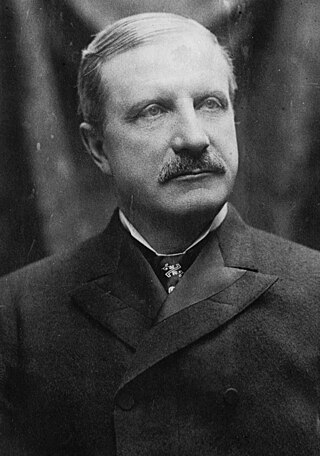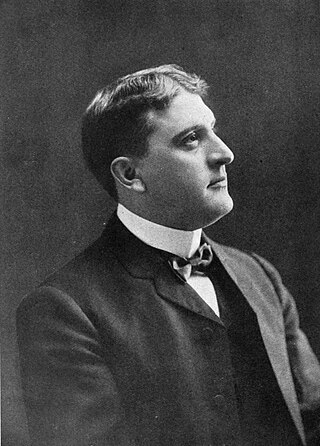
William Avery Rockefeller Jr. was an American businessman and financier. Rockefeller was a co-founder of Standard Oil along with his elder brother John Davison Rockefeller. He was also a part owner of Anaconda Copper, which was the fourth-largest company in the world by the late 1920s. Rockefeller started his business career as a clerk at 16. In 1867, he joined his brother's company, Rockefeller, Andrews & Flagler, which later became Standard Oil. The company was eventually split up by the Supreme Court in 1911. Rockefeller also had a significant involvement in the copper industry. In 1899, Rockefeller and Standard Oil principal Henry H. Rogers joined with Anaconda Company founder Marcus Daly to create the Amalgamated Copper Mining Company, which later returned to the name Anaconda Copper.

Marcus Daly was an Irish-born American businessman known as one of the four "Copper Kings" of Butte, Montana, United States.

Butte is a consolidated city-county and the county seat of Silver Bow County, Montana, United States. In 1977, the city and county governments consolidated to form the sole entity of Butte-Silver Bow. The city covers 718 square miles (1,860 km2), and, according to the 2020 census, has a population of 34,494, making it Montana's fifth-largest city. It is served by Bert Mooney Airport with airport code BTM.

The Berkeley Pit is a former open pit copper mine in the western United States, located in Butte, Montana. It is one mile (1.6 km) long by one-half mile (800 m) wide, with an approximate depth of 1,780 feet (540 m). It is filled to a depth of about 900 feet (270 m) with water that is heavily acidic, about the acidity of Coca-Cola, lemon juice, or gastric acid. As a result, the pit is laden with heavy metals and dangerous chemicals that leach from the rock, including copper, arsenic, cadmium, zinc, and sulfuric acid.

Anaconda, county seat of Deer Lodge County, which has a consolidated city-county government, is located in southwestern Montana, United States. Located at the foot of the Anaconda Range, the Continental Divide passes within 8 mi (13 km) south of the community. As of the 2020 census the population of the consolidated city-county was 9,421, and the US Census Bureaus's 2015-2019 American Community Survey showed a median household income of $41,820. Anaconda had earlier peaks of population in 1930 and 1980, based on the mining industry. As a consolidated city-county area, it ranks as the ninth most populous city in Montana, but as only a city is far smaller. Central Anaconda is 5,335 ft (1,626 m) above sea level, and is surrounded by the communities of Opportunity and West Valley.

The Anaconda Copper Mine was a large copper mine in Butte, Montana that closed operations in 1947 and was eventually consumed by the Berkeley Pit, a vast open-pit mine. Originally a silver mine, it was bought for $30,000 in 1881 by an Irish immigrant named Marcus Daly from Michael Hickey, a Civil War veteran, and co-owner Charles X. Larabie. From this beginning Daly, along with partners George Hearst, James Ben Ali Haggin and Lloyd Tevis, created the Anaconda Copper Mining Company, which ultimately became a global mining enterprise that would go on to mine 18 billion pounds of copper over 100 years. At the height of The Anaconda Copper Mining Company, it consisted of the Anaconda and other Butte mines, a smelter at Anaconda, Montana, processing plants in Great Falls, Montana, the American Brass Company, and many other properties spanning multiple countries.
The Missoulian is a daily newspaper printed in Missoula, Montana, United States. The newspaper has been owned by Lee Enterprises since 1959. The Missoulian is the largest published newspaper in Western Montana, and is distributed throughout the city of Missoula, and most of Western Montana.

James Edward Murray was an American politician and United States Senator from Montana, and a liberal leader of the Democratic Party. He served in the United States Senate from 1934 until 1961.

The Copper Kings were industrialists Marcus Daly, William A. Clark, James Andrew Murray and F. Augustus Heinze. They were known for the epic battles fought in Butte, Montana, and the surrounding region, during the Gilded Age, over control of the local copper mining industry, the fight that had ramifications for not only Montana, but the United States as a whole.

Frederick "Fritz" Augustus Heinze was an American businessman, known as one of the three Copper Kings of Butte, Montana, along with William Andrews Clark and Marcus Daly. Contemporary assessments variously described him as an intelligent, charismatic but also devious character. To some people in Montana, he was seen as a hero for standing up to the Amalgamated Copper Company, but he also eventually sold his Butte interests to Amalgamated for a reported $12 million. Thereafter, he played a significant role in the Panic of 1907, for which he was indicted but eventually exonerated. Ultimately, Heinze's flamboyant, hard-drinking lifestyle resulted in a hemorrhage of the stomach thought to be caused by cirrhosis of the liver, and he died in November 1914, aged 44.

The Butte, Anaconda and Pacific Railway is a short line railroad in the U.S. state of Montana. The BA&P was founded in 1891 and operated as such until sale in 1985, when it was renamed the Rarus Railway. The railway was again sold in May 2007 to the Patriot Rail Corporation, and the name returned to the Butte, Anaconda and Pacific Railway in July 2007. The railway was the main conduit for ore transport between Butte and Anaconda, and was used for filming of portions of the 1985 Golden Globe nominated movie Runaway Train.
On April 21, 1920, during a miners strike in Butte, Montana's copper mines, company guards fired on striking miners picketing near a mine of the Anaconda Copper Mining Company, killing Tom Manning and injuring sixteen others, an event known as the Anaconda Road massacre. His death went unpunished.
The Anaconda Copper Mining Company, known as the Amalgamated Copper Company from 1899 to 1915, was an American mining company headquartered in Butte, Montana. It was one of the largest trusts of the early 20th century and one of the largest mining companies in the world for much of the 20th century.
The United Copper Company was a short-lived United States copper mining business in the early 20th century that played a pivotal role in the Panic of 1907.

Samuel Thomas Hauser was an American industrialist and banker who was active in the development of Montana Territory. He made his first fortune in silver mines and railroads, but he lost everything in the Panic of 1893. He restored his fortune by building hydroelectric dams, only to lose it all again after his Hauser Dam burst. In addition to his many business interests, he was appointed the 7th Governor of the Montana Territory, serving from 1885 to 1887.
The Boston and Montana Consolidated Copper and Silver Mining Company was a mining, smelting, and refining company which operated primarily in the state of Montana in the United States. It was established in 1887 and merged with the Amalgamated Copper Company in 1901. The Amalgamated Copper Company changed its name to Anaconda Copper in 1910, and became one of America's largest corporations. Historian Michael P. Malone has written, "Well financed and well managed, the Boston and Montana came to rank among the world's greatest copper companies."
Montana Resources LLP is an American mining company with headquarters in Butte, Montana. The company is owned by businessman Dennis Washington as a unit of The Washington Companies. The company employs about 350 people, and operates the Continental mine, an open pit copper and molybdenum mine at Butte. The Continental pit is the only active mining operation at Butte.

The Butte, Montana labor riots of 1914 were a series of violent clashes between copper miners at Butte, Montana. The opposing factions were the miners dissatisfied with the Western Federation of Miners local at Butte, on the one hand, and those loyal to the union local on the other. The dissident miners formed a new union, and demanded that all miners must join the new union, or be subject to beatings or forced expulsion from the area. Sources disagree whether the dissidents were a majority of the miners, or a militant minority. The leadership of the new union contained many who were members of the Industrial Workers of the World (I.W.W.), or agreed with the I.W.W.'s methods and objectives. The result of the dispute between rival unions was that the copper mines of Butte, which had long been a union stronghold for the WFM, became open shop employers, and recognized no union from 1914 until 1934.

Butte is a city in southwestern Montana established as a mining camp in the 1860s in the northern Rocky Mountains straddling the Continental Divide. Butte became a hotbed for silver and gold mining in its early stages, and grew exponentially upon the advent of electricity in the late-nineteenth century due to the land's large natural stores of copper. In 1888 alone, mining operations in Butte had generated an output of $23 million. The arrival of several magnates in the area around this time, later known as the "Copper Kings," marked the beginning of Butte's establishment as a boomtown.
Reno Haber Sales was an American mining engineer who was Chief Geologist of Anaconda Corporation in Montana. He is known as the "father of mining geology."














